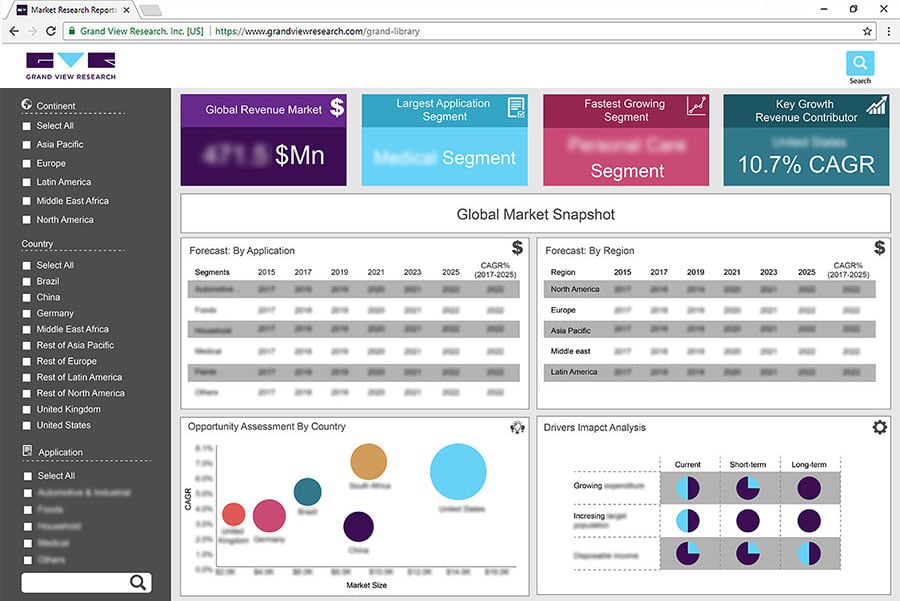
U.S. Battery Energy Storage System Market Size, Share & Trends Analysis Report By Application (Transportation, Grid Storage, UPS), By Product (Flywheel Battery, Lead Acid Battery), By Region, And Segment Forecasts, 2024 - 2030
- Report ID: GVR-4-68038-619-6
- Number of Report Pages: 76
- Format: PDF, Horizon Databook
- Historical Range: 2018 - 2022
- Forecast Period: 2024 - 2030
- Industry: Energy & Power
Table of Contents
Chapter 1 Methodology & Scope
1.1 U.S. Battery Energy Storage Systems Market Segmentation
1.2 U.S. Battery Energy Storage Systems Market Definitions
1.3 Assumptions
1.4 Information Procurement
1.4.1 Purchased Database
1.4.2 GVR’s Internal Database
1.4.3 Secondary Sources
1.4.4 Third Party Perspective
1.4.5 Primary Research
1.5 Information Analysis
1.5.1 Data Analysis Models
1.6 Market Formulation And Data Visualization
1.7 Data Validation And Publishing
Chapter 2 Executive Summary
2.1 Market Outlook
2.2 Segmental Outlook
2.3 Competitive Insights
Chapter 3 Market Variables, Trends & Scope
3.1 Market Lineage Outlook
3.1.1 Advance Battery Energy Storage Systems Market Outlook
3.2 Penetration & Growth Prospect Mapping
3.3 Industry Value Chain Analysis
3.3.1 Raw Material Trends
3.3.1.1 Major Raw Materials Analysis
3.3.1.2 Steel
3.3.1.2.1 Steel Trade Scenario
3.3.1.3 Carbon Fiber
3.3.1.3.1 Lithium
3.3.1.3.2 Lead
3.3.2 Manufacturing & Storage Trends
3.4 Comparative Cost Analysis
3.5 Technology Overview
3.5.1 Batteries
3.5.2 Flywheel
3.6 Regulatory Framework
3.6.1 Policies and Regulations
3.6.2 Standard & Compliances
3.6.3 Safety
3.7 Market Dynamics
3.7.1 Market Driver Analysis
3.7.1.1 Growing demand for uninterruptible power supply (UPS)
3.7.1.2 Rising Adoption of Electric Vehicles
3.7.2 Market Restraint Analysis
3.7.2.1 Lack of long-term energy storage
3.7.3 Opportunity Assessment
3.8 Business Environment Analysis: U.S. Battery Energy Storage Systems Market
3.8.1 Industry Analysis - Porter’s
3.8.2 PESTEL analysis
Chapter 4 U.S. Battery Energy Storage Systems Market: Application Estimates & Trend Analysis
4.1 Application Movement Analysis & Market Share, 2023 & 2030
4.2 Market Size & Forecasts and Trend Analysis, 2018 to 2030 for the Following:
4.2.1 Transportation
4.2.1.1 Market Size & Forecasts, 2018 to 2030 by application
4.2.2 Grid Storage
4.2.2.1 Market Size & Forecasts, 2018 to 2030 by application
4.2.3 UPS
4.2.3.1 Market Size & Forecasts, 2018 to 2030 by application
4.2.4 Telecom
4.2.4.1 Market Size & Forecasts, 2018 to 2030 by application
4.2.5 Others
4.2.5.1 Market Size & Forecasts, 2018 to 2030 by Application
Chapter 5 U.S. Battery Energy Storage Systems Market: Product Estimates & Trend Analysis
5.1 Product Movement Analysis & Market Share, 2023 & 2030
5.2 Market Size & Forecasts and Trend Analysis, 2018 to 2030 for the Following:
5.2.1 Flywheel battery
5.2.1.1 Market Size & Forecasts, 2018 to 2030 by product
5.2.2 Lead acid battery
5.2.2.1 Market Size & Forecasts, 2018 to 2030 by product
5.2.3 Lithium-ion battery
5.2.3.1 Market Size & Forecasts, 2018 to 2030 by product
5.2.4 Others
Chapter 6 U.S. Battery Energy Storage Systems Market - Competitive Analysis
6.1 Key Global Players & Recent Developments & their Impact on the Industry
6.2 Vendor Landscape
6.2.1 List of Key Distributors and Channel Partners
6.3 Key Company Market Ranking Analysis, 2023
6.3.1 Competitive Heat Map Analysis
6.4 Company Market Positioning
Chapter 7 Company Profile
7.1 General Electric.
7.1.1 Company Overview
7.1.2 Financial Performance
7.1.3 Product benchmarking
7.1.4 Strategic Initiatives
7.2 Hitachi, Ltd.
7.2.1 Company Overview
7.2.2 Financial Performance
v7.2.3 Product benchmarking
7.2.4 Strategic initiatives
7.3 Exide Technologies
7.3.1 Company Overview
7.3.2 Product Benchmarking
7.3.3 Strategic Initiatives
7.4 NGK INSULATORS, LTD.
7.4.1 Company Overview
7.4.2 Financial Performance
7.4.3 Product benchmarking
7.4.4 Strategic Initiatives
7.5 ENERSYS
7.5.1 Company Overview
7.5.2 Financial Performance
7.5.3 Product benchmarking
7.5.4 Strategic Initiatives
7.6 The AES Corporation
7.6.1 Company Overview
7.6.2 Financial Performance
7.6.3 Product benchmarking
7.6.4 Strategic Initiatives
7.7 SAMSUNG SDI CO., LTD
7.7.1 Company Overview
7.7.2 Financial Performance
7.7.3 Product benchmarking
7.7.4 Strategic Initiatives
7.8 Amber Kinetics, Inc.
7.8.1 Company Overview
7.8.2 Product Benchmarking
7.8.3 Strategic Initiatives
7.9 Powerthru
7.9.1 Company Overview
7.9.2 Product Benchmarking
7.10 Altairnano
7.10.1 Company Overview
7.10.2 Product Benchmarking
List of Tables
Table 1 List of major exporting countries for various steel products, 2023 (MT)
Table 2 List of major importing countries for various steel products, 2023 (MT)
Table 3 Net exports (exports - imports) for steel products for major countries, 2023 (MT)
Table 4 Net imports (imports - exports) for steel products for major countries, 2023 (MT)
Table 5 Capital costs of flywheel systems
Table 6 Capital cost of Li-ion battery systems
Table 7 Capital cost of lead-acid battery systems
Table 8 U.S. UPS Market, 2018 - 2030 (USD Million)
Table 9 Flywheel Battery Market, 2018 - 2030 (USD Million)
Table 10 Flywheel Battery Market Size & Forecasts, 2018 to 2030, by backup duration (USD Million)
Table 11 Lead acid battery Market, 2018 - 2030 (USD Million)
Table 12 Lead acid battery market Size & Forecasts, 2018 to 2030, by backup duration (USD Million)
Table 13 Lithium-ion battery Market, 2018 - 2030 (USD Million)
Table 14 Lithium-ion battery Market Size & Forecasts, 2018 to 2030, by backup duration (USD Million)
Table 15 Other Battery Market, 2018 - 2030 (USD Million)
Table 16 Transportation application of U.S. battery energy storage systems market, 2018 - 2030 (USD Million)
Table 17 Grid Storage application of U.S. battery energy storage systems market, 2018 - 2030 (USD Million)
Table 18 UPS application of U.S. battery energy storage systems market, 2018 - 2030 (USD Million)
Table 19 Telecom application of U.S. battery energy storage systems market, 2018 - 2030 (USD Million)
Table 20 Other applications of U.S. battery energy storage systems market, 2018 - 2030 (USD Million)
List of Figures
Fig. 1 U.S. Battery Energy Storage Systems Market Segmentation
Fig. 2 Information procurement
Fig. 3 Primary research pattern
Fig. 4 Primary research process
Fig. 5 Primary research approaches
Fig. 6 US Battery Energy Storage Systems market - Penetration & growth prospect mapping
Fig. 7 U.S. Battery Energy Storage Systems Market - Industry Value Chain Analysis
Fig. 8 Carbon Fiber Demand, 2018 - 2030 (Tons)
Fig. 9 Global lithium consumption, by application, 2023 (%)
Fig. 10 Capital cost vs. runtime for energy storage methods
Fig. 11 Market driver impact analysis
Fig. 12 Global electric vehicle sales, 2018 - 2030 (Thousand Units)
Fig. 13 Market restraint impact analysis
Fig. 14 U.S. Battery energy storage systems market analysis - Porter’s
Fig. 15 U.S. Battery energy storage systems market analysis - PESTEL analysis
Fig. 16 U.S. Battery Energy Storage Systems Market: Product Movement Analysis, 2023 & 2030
Fig. 17 U.S. Battery Energy Storage Systems Market: Application Movement Analysis, 2023 & 2030
Fig. 18 Competitive Heat Map Analysis



